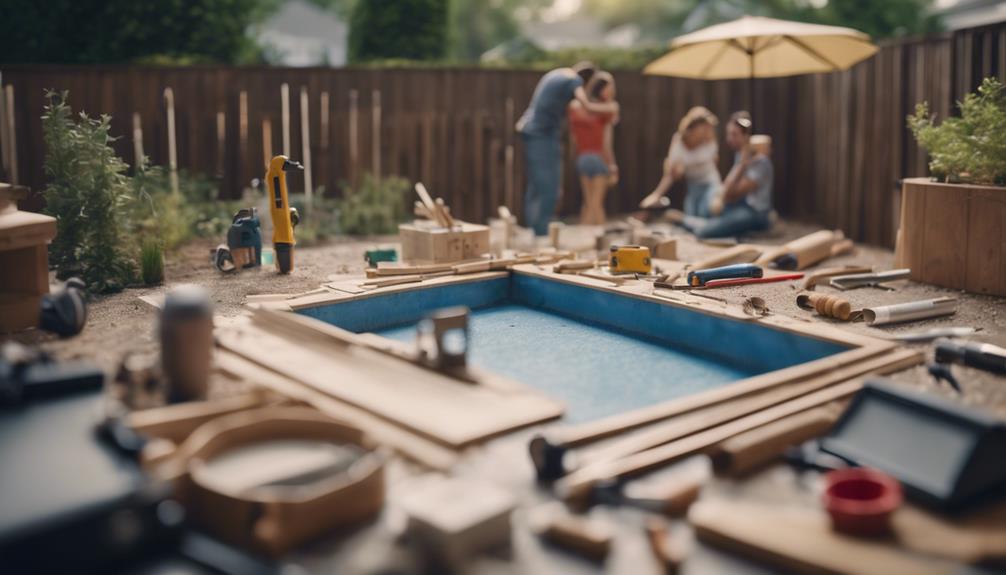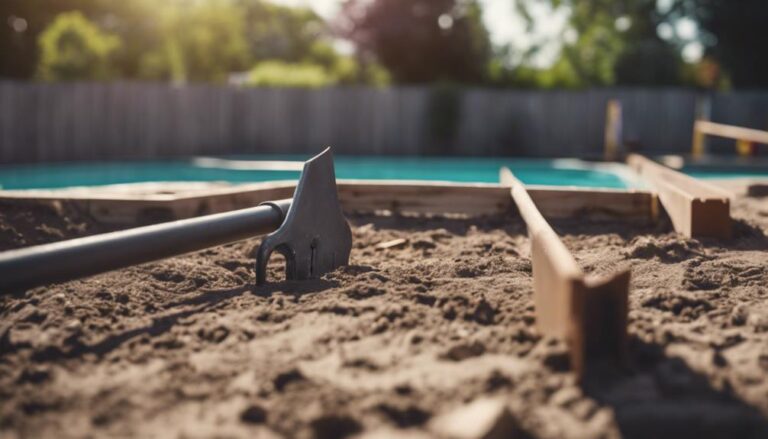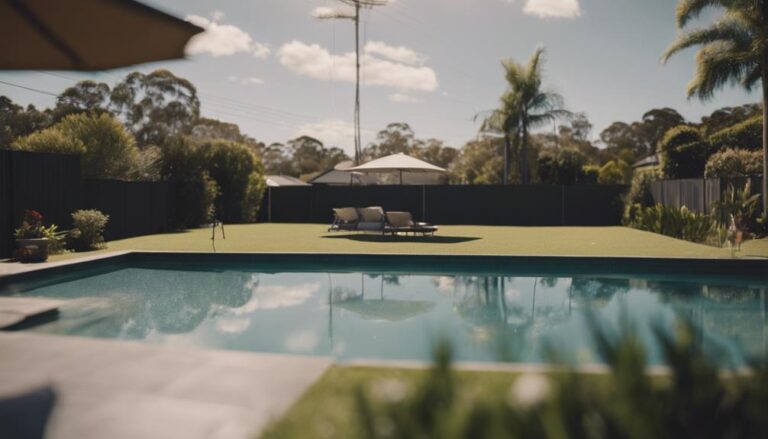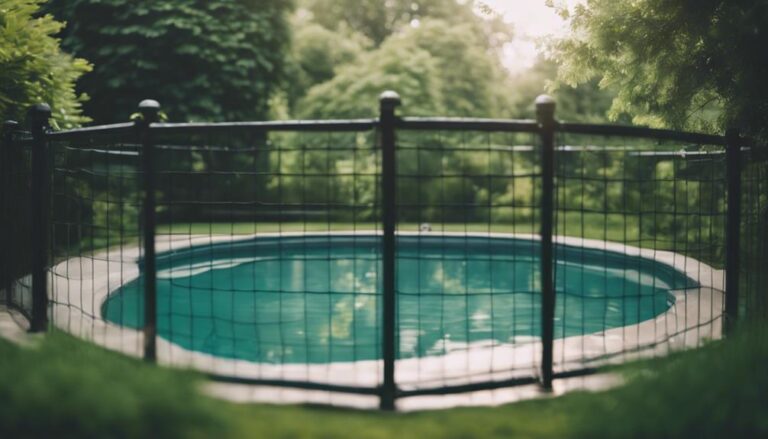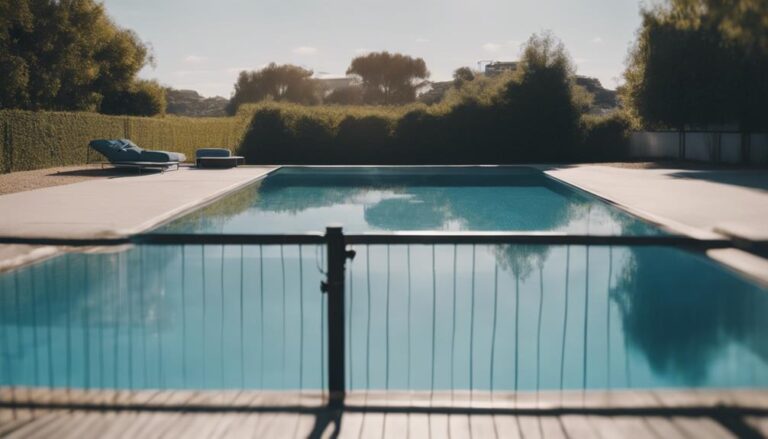Can you build your own pool fence?
Yes, you can build your own pool fence, but it is essential to follow specific safety standards and local regulations to ensure both security and compliance with the law. Your fence should be at least 1200mm in height, have gaps no wider than 100mm, and be made from materials such as toughened glass or sturdy metals that meet safety regulations.
Planning the design, choosing suitable materials and tools, and understanding the installation process are crucial aspects. Additionally, including safety features like self-closing gates and committing to regular maintenance will improve security.
Taking on this project not only guarantees compliance and functionality but also provides a satisfying sense of achievement. Learn how to tackle this task confidently.
Understanding Pool Barriers
When considering the safety of your swimming pool, it's vital to understand the requirements and options for pool barriers as a critical first step. Ensuring your pool meets safety regulations not only safeguards your loved ones but also complies with legal mandates. Pool fencing must adhere to specific criteria, including a minimum height of 1200mm and gaps that don't exceed 100mm from the ground. This design prevents young children from squeezing through or climbing over, significantly reducing the risk of accidents.
Furthermore, glass panels utilised in pool barriers offer a sleek, modern look without compromising safety. These must be reinforced and designed without ledges greater than 10mm on the outside to deter climbing. It's crucial to select materials that meet these stringent requirements to ensure your pool area is both safe and compliant.
Temporary pool fences also offer a flexible solution for those requiring immediate, short-term safety measures. With proper inspection and approval, they can serve effectively for up to 3 months. The goal is to establish a secure environment around your swimming pool, utilising fencing options that meet or exceed safety standards while preserving the beauty of your outdoor space.
Checking Local Regulations
Before commencing construction of your pool fence, it is essential to familiarise yourself with the local regulations governing height, materials, and design specifications. Early research into these rules ensures that your project complies with safety standards while meeting your design preferences.
Local regulations serve as a guide to ensure that your pool fence is both secure and compliant. You will need to confirm whether permits or approvals are required before beginning construction. This step is crucial to avoid legal issues or the need to modify your fence at a later stage. Additionally, understanding setback requirements from property boundaries and pool edges is essential for compliance and functionality.
Please be aware that restrictions on fence types, colours, or features may influence your design choices. These limitations are in place to maintain a certain standard within communities and ensure that safety is not compromised by design preferences.
For those who find it challenging to understand these regulations, it may be wise to seek assistance from a professional. Experts in the field can help you grasp the intricacies of local codes, obtain the necessary permits, and ensure that your pool fence meets both legal requirements and your personal preferences.
Planning Your Fence Layout
After familiarising yourself with the local regulations, the next step is to carefully design the layout of your pool fence to ensure both safety and functionality. The positioning of your pool fence is crucial for maintaining easy access while also providing a comfortable area for relaxation. Therefore, the planning phase begins with determining the exact placement that balances convenience with visual appeal.
Before moving forward with any physical work, it is important to check for underground utilities. This step helps prevent any disruptions and ensures the safety of the installation process. Additionally, obtaining the necessary permissions from local authorities is not just a procedural requirement; it is a vital step to confirm that your fence complies with all safety regulations.
Once the administrative groundwork is in place, use stakes and a string line to mark the intended line of the fence. This visual guide will assist in ensuring accurate placement and help visualise the final appearance of the project. The next step involves planning the spacing for your posts and panels according to the chosen design of your fence. This is crucial for a proper installation and to achieve the desired aesthetic and functional outcome.
Selecting Materials and Tools
Selecting appropriate materials and tools is crucial for constructing a sturdy and visually appealing pool fence that meets safety and design requirements. The choice of materials such as aluminium, steel, or glass not only impacts the fence's durability and strength but also its aesthetic appeal. Aluminium and steel, with their powder-coated finishes, offer durability and resistance to weather conditions, ensuring the fence lasts a long time. On the other hand, glass provides a modern and stylish look, elevating your pool area into a chic retreat.
To ensure a smooth installation process, it is essential to have the right tools. A post hole digger, level, drill, and concrete mix are essential for securely and accurately installing your fence panels. Opting for pre-made fence panels can simplify the assembly and ensure a uniform appearance, enhancing the overall look of your pool area.
| Materials | Tools |
|---|---|
| Aluminium | Post hole digger |
| Steel | Level |
| Glass | Drill |
| Powder-coated finishes | Concrete mix |
| Pre-made fence panels | – |
Careful selection of these materials and tools will not only secure your pool but also enhance its appearance, making it a standout feature of your home.
Installing Fence Posts
Now that you've selected your materials and tools, it's time to focus on installing your pool fence posts with precision.
You'll start by choosing the right materials, ensuring you have durable posts that can withstand the elements.
Accurate marking, measuring, and secure digging and setting are key steps to guarantee your fence's stability and uniform appearance, making your pool area both safe and stylish.
Selecting the Correct Materials
Selecting the appropriate materials for the installation of fence posts is crucial to ensure the longevity and stability of your pool fence. The foundation of a long-lasting fence lies in strong corner and gate posts, anchored securely with concrete for unmatched stability. This stage is essential for a fence that withstands both time and weather.
Achieving uniformity along your fence line is vital for a professional appearance. This involves precise measurement and marking of post heights, ensuring each post is perfectly aligned with the next. The use of top rail flanges not only aids panel installation but also ensures precise alignment, enhancing the structural integrity and visual appeal of your fence.
The success of your fencing project is determined by the choice of materials and careful installation.
Marking and Measuring Accurately
Having selected the appropriate materials for your pool fence, it's crucial to concentrate on precise marking and measuring to ensure the posts are installed correctly. Precision in these steps not only secures stability but also guarantees the uniformity of your fence. By employing a string line for the heights of posts, you can achieve accurate cuts, maintaining consistency throughout.
| Step | Description |
|---|---|
| Dig Holes | 200mm square, 600mm deep for corner and gate posts. |
| Prop Posts | Ensure corner posts are vertical before concrete fill. |
| Measure & Mark | Mark heights on all posts for consistency. |
| Set String Line | Use for accurate post heights and top rail alignment. |
Following these steps closely will ensure precision and a professional finish for your DIY pool fence project.
Digging and Setting Securely
Why not ensure the longevity and stability of your pool fence by mastering the technique of digging and setting your fence posts securely?
Begin by excavating holes measuring 200mm square and 600mm deep for corner and gate posts, providing a solid foundation for stability and support. Ensure your corner posts are vertically aligned and fill the holes with concrete to firmly set them, guaranteeing long-lasting durability.
Measure and mark the heights for all posts accurately, keeping uniformity and alignment along your fence line. Use a string line to verify that post heights are consistent, and trim the posts accordingly for a level, seamless appearance.
Lastly, attach top rail flanges to the posts, simplifying the panel installation and reinforcing the overall structure of your pool fence. Following these steps will lead you to a professionally installed pool fence.
Attaching Panels and Rails
After selecting your fence panels, the next step of attaching the panels and rails is crucial for building a secure and visually pleasing pool fence. Following specific steps will help to create a secure and professional installation.
- Fixing bottom rail flanges to fence panels: This simplifies the attachment process and ensures stability from the base.
- Securing panels to posts with tek screws: Tek screws are essential for a strong and long-lasting connection, ensuring the fence withstands the elements and regular use.
- Using blocks to ensure panels are level during installation: Keeping a level fence is important for a consistent and professional look, reflecting superior craftsmanship.
- Drilling and firmly securing bottom flanges to posts: This step improves the fence's durability and strength.
- Installing panels progressively along the predetermined line: This method guarantees a uniform and aesthetically pleasing appearance, turning your pool fence into an asset for your property's visual appeal.
Adding Safety Features
To improve the security of your pool fence, it is recommended to include advanced safety features such as gates that close and latch automatically. These innovations are not just for convenience; they are critical for maintaining a secure environment around your pool, especially if you have young children or pets. Gates that close by themselves ensure that the pool area is always securely enclosed after someone passes through, while mechanisms that latch automatically provide an additional level of security, preventing accidental or unauthorised access.
Moreover, installing alarms on gates offers peace of mind by alerting you each time the gate is opened. This additional security measure is invaluable for monitoring who enters the pool area. To further deter unauthorised entry, choose materials for your fence that cannot be easily climbed. This ensures that the barrier cannot be easily overcome by adventurous children or potential intruders.
For comprehensive safety, ensure there is clear visibility through your fence. This allows for monitoring of the pool area from a distance. Additionally, consider installing motion-sensitive lights around the fence. These lights enhance visibility and security, ensuring the pool area is well illuminated during night-time use. Collectively, these safety features significantly enhance the security of your pool fence, creating an effective barrier against potential hazards.
Conducting a Final Inspection
Once you've built your pool fence, carrying out a final inspection is essential to make sure everyone's safety.
You'll need to go through a final inspection checklist, confirm compliance with safety regulations, and deal with any potential issues promptly.
This step is vital to ensure that your pool area is secure and ready for use.
Final Inspection Checklist
Before immersing yourself in the invigorating waters of your newly built pool, it's imperative to conduct a thorough inspection of the pool fence to ensure the safety and legal compliance of your garden sanctuary.
As you approach this final phase, be aware that constructing a pool fence that adheres to local regulations and standards is paramount not only for its appearance but, more significantly, for safety. Utilise this checklist as your guide:
- Confirm that all components of the fence are securely installed and adhere to the required height and gap specifications.
- Inspect the vicinity of the fence for any objects that could be used to climb over it, both inside and outside the pool area.
- Check that gates are equipped with self-closing and self-latching mechanisms that are childproof.
- Examine glass panels to ensure they're stable, made of reinforced glass, and of an adequate height.
- Ensure the pool fence is in compliance with local safety regulations and standards concerning pools.
Proceed with these steps methodically to guarantee the safety and regulatory compliance of your pool area.
Safety Compliance Verification
Ensuring the safety and compliance of your swimming pool necessitates a thorough final inspection, following strict standards. It is vital to confirm that your pool barrier meets all safety regulations to ensure it provides the intended protection.
Start by checking that the barrier height is at least 1200mm, a crucial measurement to deter unauthorised access. Look for any gaps within 100mm from the ground, closing off potential entry points.
Furthermore, ensure there are no objects that can be climbed within 900mm outside the barrier and no items within the barrier perimeter that could aid climbing within 300mm. These steps help maintain the barrier's effective height and prevent security breaches.
By conducting detailed checks, you will achieve compliance, guaranteeing that your pool area is safe and secure in line with the highest safety standards.
Addressing Potential Issues
After confirming that your pool fence adheres to all necessary safety standards, it is crucial to conduct a thorough inspection to identify any possible issues that could compromise its integrity. This final step ensures that your pool fence not only meets regulations but also provides maximum safety for your family and guests.
- Ensure that the fence height is at least 1200mm to discourage individuals from easily climbing over it.
- Check that there are no gaps wider than 100mm between the fence and the ground to prevent small animals or children from getting through.
- Make sure that gate posts are correctly positioned for proper gate installation, which will enable smooth operation.
- Confirm that all screws and bolts are securely tightened to prevent any loose parts that could lead to structural failure.
- Inspect the entire structure for any signs of damage or wear that could compromise safety.
This thorough inspection process is essential for maintaining the safety and security of your pool area.
Maintenance and Upkeep
To maintain the safety and appearance of your pool fence, carrying out regular maintenance and inspections is vital. This ensures the fence not only looks good but also serves its purpose in securing your pool area effectively. Start by regularly checking fence panels for signs of instability, wear, or deterioration. Quickly addressing these issues is crucial to reduce potential risks.
For those with glass panels, maintenance is simple. Using a mild detergent and water will keep them perfectly clear, ensuring views remain unobstructed while maintaining a high safety standard. Plants near the fence may inadvertently offer climbing opportunities for children; therefore, it's important to trim any vegetation or shrubs close to the fence line.
The functionality of gate hinges and latches should not be overlooked. Regular inspections are essential to ensure they are secure and working smoothly. This part of maintenance goes beyond basic care; it's about guaranteeing the safety and security of your pool area.
Arranging professional maintenance checks annually is beneficial for the longevity of your fence, ensuring compliance with safety standards, and providing peace of mind. By following these maintenance tips, you are not just looking after a fence; you are committing to a safe and visually pleasing environment around your pool.
Frequently Asked Questions
Can you install a pool fence yourself?
Yes, you can install a pool fence yourself, saving on labour costs and enabling customisation. Despite the satisfaction of completing the project, remember it's time-consuming and mistakes can lead to additional expenses.
Can you build your own pool in Australia?
Yes, you can construct your own swimming pool in Australia as long as you comply with local regulations and safety standards. It is important to follow the legal requirements for building and design to make sure that your pool is safe and meets regulations.
What are the rules for pool fencing in Australia?
In the UK, your pool fence must be at least 1200mm high with gaps under 100mm. Ensure no climbable objects are within 900mm outside and 300mm inside the fence for your family's safety and compliance.
Can I build my own pool fence in Victoria?
Yes, you can construct your own pool fence in Victoria, ensuring it complies with safety standards, including a minimum height of 1200mm and no wide gaps. Remember, adhering to local regulations is essential to avoid penalties.
